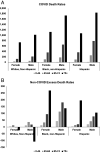Excess mortality from COVID and non-COVID causes in minority populations
- PMID: 34544858
- PMCID: PMC8488621
- DOI: 10.1073/pnas.2101386118
Excess mortality from COVID and non-COVID causes in minority populations
Abstract
The 2020 US mortality totaled 2.8 million after early March, which is 17.3% higher than age-population-weighted mortality over the same time interval in 2017 to 2019, for a total excess death count of 413,592. We use data on weekly death counts by cause, as well as life tables, to quantify excess mortality and life years lost from both COVID-19 and non-COVID-19 causes by race/ethnicity, age, and gender/sex. Excess mortality from non-COVID-19 causes is substantial and much more heavily concentrated among males and minorities, especially Black, non-Hispanic males, than COVID-19 deaths. Thirty-four percent of the excess life years lost for males is from non-COVID-19 causes. While minorities represent 36% of COVID-19 deaths, they represent 70% of non-COVID-19 related excess deaths and 58% of non-COVID-19 excess life years lost. Black, non-Hispanic males represent only 6.9% of the population, but they are responsible for 8.9% of COVID-19 deaths and 28% of 2020 excess deaths from non-COVID-19 causes. For this group, nearly half of the excess life years lost in 2020 are due to non-COVID-19 causes.
Keywords: COVID-19; excess mortality; racial disparities.
Conflict of interest statement
The authors declare no competing interest.
Figures


References
Publication types
MeSH terms
LinkOut - more resources
Full Text Sources
Medical

